
Ceramics Illuminated
by Dr. Margaret Carney, Curator
The focus of art history has long been an examination of the history of painting, sculpture, and architecture and the artists, craftspeople and designers affiliated with these genres. Yet the frequently marginalized ceramics remain among the earliest tangible artifacts recovered from ancient civilizations, surviving in the form of effigy figures, cooking vessels, or funerary wares. It was thousands of years ago that pots were first made and fired with intentional glazes. With civilizations as advanced technologically and aesthetically as the Ancient Classic Maya, Mexican Olmec, Chinese Majiayao and others, ceramics formed an integral part of these cultures’ daily lives and the afterlife.
It has been stated that fire was discovered and humans learned to transport it one million to 500,000 years ago. Bones with evidence of burn marks can be dated in Africa to 1.4 million years ago. If one can simplistically state that the discovery of fire kept people warm, was used as a defense against predators, cooked the food, lit the homes, and fired the pots of our ancestors, then it stands to reason that there must have long been an intertwining between ceramics and lighting or illumination. There should be no shortage of examples of ceramics that interfaced with illumination, ancient or contemporary.
Best known of early ceramic lamps would be oil lamps that have been utilized from prehistoric times to present day. While oil lamp use prior to the advent electric lights was of a practical nature, such lamps today provide mood lighting or an emergency light source, an alternative to candle light. For example, Roman oil lamps, circa 1-400 A.D., comprised almost exclusively of unglazed earthenware or terracotta, come to mind. These small fired clay lamps, about 10 cm. in length are basically comprised of a pouring hole to fill the fuel chamber, a wick hole or nozzle and frequently a handle. There were many variations. The wicks were frequently papyrus, linen, flax, or rush. Most lamps were placed in lamp holders affixed to the wall, suspended from brackets, or placed in wall niches. Early oil lamps were hand-made but by Roman times stone, clay, or plaster molds were utilized.
Additionally one might have heard about the Chinese stoneware oil lamps or incense burners dating from at least as early as the Tang (618-907 A.D.) and Song dynasty (960-1279 A.D.) These, too, likely involved the use of simply wicks and oil. Some surviving examples were created out of Ting ware, Qingbai ware, Northern celadons, and Cizhou ware stoneware and would have been utilized by the Song dynasty upwardly mobile merchant class. Beautiful Song oil lamps or incense burners can be seen in the collection of the Indianapolis Museum of Art, the Nelson-Atkins Museum of Art in Kansas City, the Everson Museum in Syracuse, New York, and the Museum of Fine Arts, Boston. One thing the Chinese Song lamps and the ancient Roman lamps had in common besides the use of wicks and oil, is that neither was created from porcelain, but rather earthenware and stoneware.
Most people think of the translucency of porcelain when considering how ceramics and light have complemented each other throughout time. Porcelain was first discovered in China by the Tang dynasty (618-907), and one thousand years later, the alchemist Johann Friedrich Böttger uncovered this secret at the Meissen factory in Dresden. So now Europe, too, had porcelain. The Chinese had been using lanterns made of various materials for at least hundreds of years, but their best known use of the translucency of porcelain was in the very fine carving of Ming and Qing dynasty porcelain bowls – with designs of writhing dragons and scrolling floral motifs, finely potted in porcelain, with a layer of paper thin glaze highlighting the decoration visible with backlighting. A beautiful Ming dynasty, Yongle period (1403-1424) bowl can be seen the collection of the British Museum, London. Later Qing dynasty examples exist in the collections such as the Seattle Art Museum, which owns a beautiful Qianlong period (1736-1795) bowl with a reticulated design produced at Jingdezhen. A Qing dynasty Yongzheng period (1723-1735) dish often referred to as “Dragon in Clouds,” from the collection of the Flint Institute of Arts is included in the special exhibition Ceramics Illuminated. Highly translucent Chinese Dehua or Blanc de Chine porcelain from Fujian Province, dating from the Ming dynasty onwards, is another exquisite example of how ceramics and light have been married. The finest examples can not be fully appreciated unless these small cups and bowls are backlit – when marvelous carved, molded and incised designs are revealed. Several of the finest examples are in the collection of the Asian Civilisations Museum in Singapore.
About the same time, the late 18th or early 19th century, the Chinese produced rare carved or mold-made bisque or parian ware translucent porcelain cups, boxes and brush holders that resembled carved ivory. When backlit, each becomes magical, with exquisite details revealed. Two small cups of this genre are featured in Ceramics Illuminated. In addition to these cups from a private collection, there are other examples in the collection of the Victoria & Albert Museum in London.
Undoubtedly inspired by Chinese porcelains, Blanc de Chine, and the late 18th-early 19th century bisque ware examples just mentioned, French entrepreneur Baron Charles Paul de Bourgoing created and patented lithophanes in the 1820s. Lithophanes are porcelain plaques formed in a mold cast from a model made in wax, which when backlit have the appearance of being painted in grisaille (a style of monochrome painting in shades of gray, used especially for the representation of relief sculpture). They appear as strange bumpy white objects when viewed with reflected light. Yet when illuminated from behind, the delicate image magically appears, with all the gradations of light and shadow, with the resulting image as clear as a mezzotint. Where the porcelain is thicker, less light can penetrate and a dark effect is created; and where the porcelain is thinner, more light is transmitted and that area of the lithophane appears bright. The front surface has a three-dimensional picture in low relief, while the back is flat and smooth. The Blair Museum of Lithophanes in Toledo owns the largest collection of lithophanes in the world, with more than 2,350 examples from Austria, Belgium, Bohemia/Czechoslovakia, Denmark, England, France, Germany, Hungary, Ireland, Italy, Japan, Norway, Portugal, Russia, Sweden, the United States and Wales. More than 700 lithophanes are currently on exhibition, shown as plaques, and utilized in useful illuminated objects for the home – candle shields, table screens, lamps and shades, nightlights, tea warmers, fireplace screens, doll house miniatures, complexion fans, beer stein bottoms, interiors of souvenir or commemorative memorabilia, erotica, lanterns, match boxes, devotional home worship pieces, mug and cup interiors, and fairy lamps. These pieces were lit by sunlight, candles, oil, and fireplaces. Although lithophanes are still being manufactured today in factories worldwide and created by individual artists, their popularity waned after electricity became commonplace.
Oddly enough, lithophanes may have been the most popular and prolific expression representing the successful merging of ceramics and illumination. Tens of thousands were manufactured in the 19th century. They were wildly popular. Few people speak of them today. The other popular format for combining ceramics and light, oil lamps, continue to be manufactured today, but they are largely appreciated for mood lighting or as an emergency light source, in lieu of candles.
Even more surprising than the obscurity of esoteric lithophanes, is the fact that not much new has been produced in terms of ceramics and light in the past 400-900 years. An artist or factory may periodically resurrect the idea of lithophanes or oil lamps as a nostalgic offering, but little experimental work, technologically or aesthetically has been forthcoming. It seems that the Ceramics Illuminated exhibition may be the first museum presentation purporting to capture this marriage of clay and light.
One must mention that in addition to oil lamps, ceramic lamp bases, mostly stoneware, complete with threaded cords, incandescent bulbs, and lamp shades have been viable commodities from at least as early as the Art Pottery era in the 1920s and 30s through the 1960s and 70s. Mass-produced and one-of-a-kind vase-forms were either intentionally created as lamps or converted from vases to functioning lamps. Potters such as Charles Fergus Binns, Dan Rhodes, Ted Randall, and others created such work, which now would be considered more valuable if disassembled to remove the lighting fixture. They generally all look like vases converted into lamps, rather than pieces created especially with lighting as a function. There is no translucency involved either.
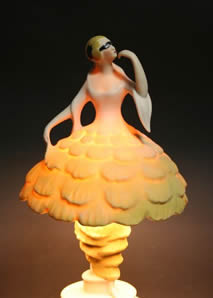 Fulper Pottery, originally located in Flemington, New Jersey, is a company that between 1910 to 1929, created some of the most memorable ceramic lamps that were illuminated by electricity. Their figural boudoir-type lamps depicting a pantalooned Bo-Peep and a masked Harlequin are prized by Fulper collectors today, as are the perfume lights and night lights, also figural in nature. It is the translucency of the ceramic, lit from within, along with the colorful and almost kitschy figures, that make these lamps so precious – who can resist illuminated and glowing skirts and pantaloons? The boudoir lamp with the Harlequin-type figure was original called The Mask Boudoir Lamp No. 331 and it was marketed in the 1920s based on the color of the figure’s skirt – flame, pink, green, orchid, yellow or blue and it originally cost $15. The smaller seated girl lamp with the hat next her was originally called The Hat Perfume Lamp No. 312. It was marketed with six decorations – apricot and turquoise, canary and black, lavender and rose, jade and lavender, blue and orange, and rose and blue. It originally sold for $10. Unfortunately for posterity, William Fulper died in 1928 and his pottery burned to the ground in 1929.
Fulper Pottery, originally located in Flemington, New Jersey, is a company that between 1910 to 1929, created some of the most memorable ceramic lamps that were illuminated by electricity. Their figural boudoir-type lamps depicting a pantalooned Bo-Peep and a masked Harlequin are prized by Fulper collectors today, as are the perfume lights and night lights, also figural in nature. It is the translucency of the ceramic, lit from within, along with the colorful and almost kitschy figures, that make these lamps so precious – who can resist illuminated and glowing skirts and pantaloons? The boudoir lamp with the Harlequin-type figure was original called The Mask Boudoir Lamp No. 331 and it was marketed in the 1920s based on the color of the figure’s skirt – flame, pink, green, orchid, yellow or blue and it originally cost $15. The smaller seated girl lamp with the hat next her was originally called The Hat Perfume Lamp No. 312. It was marketed with six decorations – apricot and turquoise, canary and black, lavender and rose, jade and lavender, blue and orange, and rose and blue. It originally sold for $10. Unfortunately for posterity, William Fulper died in 1928 and his pottery burned to the ground in 1929.
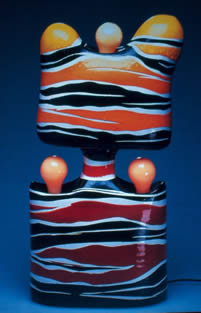 Ka-Kwong Hui (b. Hong Kong 1922-2003) was a ceramic genius, a designer and maker extraordinaire whose bountiful creativity placed him in an art world surrounded by individuals of the calibre of Pop artist Roy Lichtenstein (with whom he collaborated in 1964-65), and Stephen De Staebler (Hui’s student at The Brooklyn Museum School in New York in 1957). Hui is one of the few artists of the 20th century who is simply referred to by one name – like the earlier Michaelangelo and Rembrandt. He is one of a handful of ceramic artists whose work is easily recognizable and his name known to a large enlightened audience along with Peter Voulkos, Robert Arneson and Howard Kottler. Unlike other famous artists, such as Picasso, Matisse, Miro, and Gaugain, who also worked in clay (implying painting or sculpture were their favored mediums), Hui was committed to clay.
Ka-Kwong Hui (b. Hong Kong 1922-2003) was a ceramic genius, a designer and maker extraordinaire whose bountiful creativity placed him in an art world surrounded by individuals of the calibre of Pop artist Roy Lichtenstein (with whom he collaborated in 1964-65), and Stephen De Staebler (Hui’s student at The Brooklyn Museum School in New York in 1957). Hui is one of the few artists of the 20th century who is simply referred to by one name – like the earlier Michaelangelo and Rembrandt. He is one of a handful of ceramic artists whose work is easily recognizable and his name known to a large enlightened audience along with Peter Voulkos, Robert Arneson and Howard Kottler. Unlike other famous artists, such as Picasso, Matisse, Miro, and Gaugain, who also worked in clay (implying painting or sculpture were their favored mediums), Hui was committed to clay.
Hui’s work always involved the use of the potter’s wheel in making basic shapes that he pulled together into sculptural and quasi-functional objects. His impact on ceramic art was first felt with his sculptural work in the 1960s. After working with Roy Lichtenstein on a series of ceramic sculptures that involved hard edge painting on low fire glazes, Hui went on to use this technique in his own work. Using bright, primary colors and exact forms which seemed almost like clay cartoons, he extended the breadth of ceramic sculpture from the Abstract Expressionist forms of Peter Voulkos into the sensibility of Pop Art.
Ancient oil lamps created a functional light source. Lithophanes enhanced and embellished existing light sources. Yet some ceramics that are illuminated have no such practical purpose. A signature piece by Hui is his Chinese Landscape Ceramic Form Lamp, 1965, now in the collection of the Schein-Joseph International Museum of Ceramic Art in Alfred, New York. With its three light bulbs and vibrant colors, this piece harkens back to Hui’s memories of Chinese mountains and valleys, and his attempt to capture a moment in time within that welcoming landscape. In an interview with Joan Gordon in 1999, Hui noted that he incorporated light bulbs into some of his art because he liked the combination of light with the piece. He thought it added another element – light. He firmly stated that he did not expect the light to make the piece functional. Sometimes the viewer might be so distracted by the painterly facade and light bulbs, not noticing that, in retrospect, his ceramic creativity also had symmetry, from earthy Chinese forms to polychrome abstraction and then shrine-like temples or immortal Taoist mountains. His was a journey of a Chinese scholar traveling through the hills and streams, across oceans and back, memories and traditions juxtaposed against new discoveries. In the end, his work transcended stereotypical categorization, and is recognizable as the work of a master known only as Hui.
If Ka-Kwong Hui envisioned the universe through his Chinese heritage, then Jack Earl sees the universe through his wise Ohio eyes and portrays it with thoughtful and often humorous intent. In other words, he references Ohio, but his work belies an all-knowing universal intuition. Born in 1934, Ohio native Jack Earl received degrees from two Ohio institutions – Bluffton College and the Ohio State University. He subsequently taught at the Toledo Museum of Art’s School of Design from 1963 to 1972 and then Virginia Commonwealth University. It isn’t easy to categorize Jack Earl’s narrative sculpture, but it is easy to see the connection between some of his sculpture and Meissen porcelain figures from the 18th and 19th centuries. His sculpture Ohio Dresser, included in Ceramics Illuminated, is the only piece in the exhibition that implies illumination but doesn’t actually deliver light or secrets through translucency.
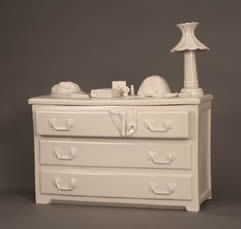 Ohio Dresser was one of a series of multiples for which Jack created the molds in 1976 in Virginia. The pieces were then cast when he was in residency at the Kohler Company later in the same year. The piece, actually a covered box in the shape of a bedroom dresser with the top drawer ajar, was composed of Kohler’s standard vitreous sanitary ware porcelain, covered with a white glaze. Each of the six editions had different objects placed on the top of the dresser – a lamp, a wallet, a 1930s radio, a book, a baseball cap. Each book is etched with the words “The Book” which is his reference for the Holy Bible. Multiples are nice because if a curator asks the Everson Museum in Syracuse, New York to borrow their version of Ohio Dresser and they never respond one can put the same request to Jack Earl’s high school art teacher in Bluffton, Darvin Luginbuhl, only to find out that the lamp was missing from the top of his copy. Finally, luck holds out and the artist himself has retained still a third version of Ohio Dresser, and it is stored in a barn but is available.
Ohio Dresser was one of a series of multiples for which Jack created the molds in 1976 in Virginia. The pieces were then cast when he was in residency at the Kohler Company later in the same year. The piece, actually a covered box in the shape of a bedroom dresser with the top drawer ajar, was composed of Kohler’s standard vitreous sanitary ware porcelain, covered with a white glaze. Each of the six editions had different objects placed on the top of the dresser – a lamp, a wallet, a 1930s radio, a book, a baseball cap. Each book is etched with the words “The Book” which is his reference for the Holy Bible. Multiples are nice because if a curator asks the Everson Museum in Syracuse, New York to borrow their version of Ohio Dresser and they never respond one can put the same request to Jack Earl’s high school art teacher in Bluffton, Darvin Luginbuhl, only to find out that the lamp was missing from the top of his copy. Finally, luck holds out and the artist himself has retained still a third version of Ohio Dresser, and it is stored in a barn but is available.
The thing about seeing Jack Earl’s work is, you never forget the first time you saw your first piece. One not only remembers the work, but one remembers the artist’s name, too. In this case, only the artist and curator know that when one lifts the Ohio Dresser lid, and places it back on top of the box, that it makes that characteristic ringing sound as when one lifts the lid on their toilet tank to jiggle the chain inside so the toilet stops running, and then carefully replaces the lid on the tank -- toilet porcelain on toilet porcelain.
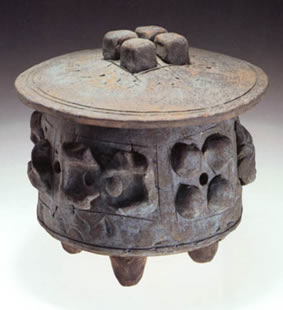 Ted Randall (1914-1985) knew he wanted to be a sculptor at the age of twelve. Perhaps this wasn’t surprising since he was born into a clay heritage. An early journal of the American clay industry, The Clay-Worker, was the family business. He received a B.F.A. degree in sculpture from Yale and his M.F.A. degree was earned at Alfred in 1949. He began teaching there in 1951, after living several years as a sculptor in New York City. Randall sacrificed his creativity as an artist at its peak in order to become the visionary leader and chair of the art department within the New York State College of Ceramics at Alfred University, from 1958 to 1973.
Ted Randall (1914-1985) knew he wanted to be a sculptor at the age of twelve. Perhaps this wasn’t surprising since he was born into a clay heritage. An early journal of the American clay industry, The Clay-Worker, was the family business. He received a B.F.A. degree in sculpture from Yale and his M.F.A. degree was earned at Alfred in 1949. He began teaching there in 1951, after living several years as a sculptor in New York City. Randall sacrificed his creativity as an artist at its peak in order to become the visionary leader and chair of the art department within the New York State College of Ceramics at Alfred University, from 1958 to 1973.
Fortunately for the art world, Ted Randall was a tireless experimenter and inventor as well as a potter, sculptor, teacher, and administrator. Even his burdensome duties as an administrator at Alfred did not stymie his total production as an artist. In his retirement in the 1980s he coined the word “sculpots” which referred to what he called a new “ceramic synthesis of sculpture and pottery.” He wrote in an article that was published in Ceramics Monthly in 1984, “I have stopped trying for the pot that has never been seen before and continue to try for the pot that recalls all pottery.”
The stoneware pots that he created in the 1980s reflect the “accrued meanings” that he desired in his work. At that time his pots reflected the best of both the pottery and sculpture worlds. A savvy private collector in Corning, New York, owns the small yet monumental Light Box, created by Randall circa 1980. While the lidded stoneware vessel is reminiscent of Chinese bronzes and Japanese lanterns, ceramist Val Cushing summed up this work in the December 1987 issue of Studio Potter, when he wrote that pieces like this, “carry a message of pottery in an envelope of sculpture.” It is easy for one to imagine the piece lit internally, like a lantern in a Japanese garden. The proof that this is possible can be seen in the burn marks one sees when lifting the lid and peeking inside. It is the only piece in the exhibit that isn’t porcelain or china of some type. It doesn’t have translucency or a shimmering white body. But it does have the promise of illumination, from ancient to contemporary.
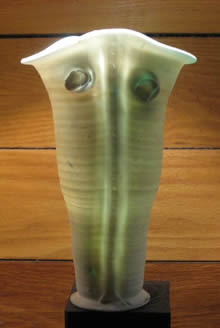 When one thinks of masters of porcelain, with its trademark translucency, the first name that comes to mind is that of Rudolph (Rudi) Staffel (1911-2002). Staffel was a student of Hans Hoffman in New York, and studied at the Art Institute of Chicago. He taught at the Tyler School of Art, Temple University, in Philadelphia from 1940 to 1978.
When one thinks of masters of porcelain, with its trademark translucency, the first name that comes to mind is that of Rudolph (Rudi) Staffel (1911-2002). Staffel was a student of Hans Hoffman in New York, and studied at the Art Institute of Chicago. He taught at the Tyler School of Art, Temple University, in Philadelphia from 1940 to 1978.
It has often been recorded that he began working with porcelain in the 1950s after he was invited to create a dinnerware set and became intrigued with the translucence properties inherent in the best porcelain. His genre of “Light Gatherers” such as the vase included in Ceramics Illuminated, transmit light through varying slabs of thick and thin porcelain when lit from above. He frequently utilized a copper oxide wash to obtain the mysterious blue tone in his glazes. Like Ted Randall sculpots, Rudi Staffel’s Light Gatherer vase forms are both functional and sculptural. And much like an abstract lithophane, a Rudi Staffel Light Gatherer cannot be fully appreciated without the proper illumination.
The Museum of Modern Art in New York City is the only collection that owns a Harry Allen ceramic foam lamp designed by Harry Allen and Associates. This table lamp, Lighting Fixture, just 13-1/2 inches high, was one of four pieces that was originally designed for the Museum of Modern Art in 1994, to be included in the exhibition titled Mutant Materials in Contemporary Design. This piece and another larger lamp were included in an exhibition titled Conspicuous Applications of Advanced Ceramics that was on view in 1997 at the International Museum of Ceramic Art in Alfred, New York. The lamp is comprised of a ceramic foam filter made from an advanced ceramic body created at Selee Corporation. According to Harry Allen Design’s website, the designer proved that this ceramic foam which is frequently utilized in industrial filtering applications, also had the ability to filter light. It’s hard to believe that a filter designed to remove impurities from molten metal can be so beautiful.
Harry Allen has written about these lamps stating that he “is inspired by new materials.” He continued, “When I saw this ceramic foam, I was working on some lighting. I held it up to the sun and it was very beautiful. That’s the inspiration. Then, it takes a long time, many trials and a very cooperative research partner such as Selee Corporation (the manufacturer) to make such a crazy idea work.” Four Harry Allen designed ceramic foam lamps were donated to the Museum of Modern Art in 1998.
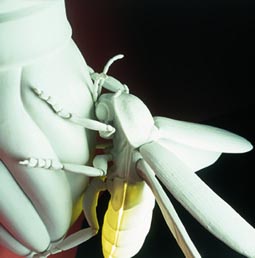 The “poster child” for this Ceramics Illuminated exhibition is a porcelain piece created by Linda Cordell in 1999. View it once and it is not forgotten. In the spirit of the glass half full or half empty, the piece is titled Pursuit of Happiness by the artist, and nicknamed Exercise in Futility by its current owner, Dr. Stanley Shapiro. It is an internally lit sculpture depicting a firefly attempting to mate with a light bulb, all white with the only color being the yellow abdomen of the firefly which flicks on and off – a signal to potential mates. The artist chose the firefly as the subject matter because it was the state insect of Pennsylvania and she had just moved to Philadelphia as the recipient of the Evelyn Shapiro Foundation Fellowship at the Clay Studio. This piece was part of her solo exhibition there. The title she gave the piece not only referred to the Declaration of Independence but also to sexual desire – the joke of the piece being the firefly mistaking the light bulb as a potential mate, which fit in with the cycle of hope (of objects, design, technology) and disillusion (not meeting expectations, unexpected consequences) that all of her work was concerned with at that time. This piece was selected for exhibition at the Everson Museum in 2000 and it traveled to a number of venues afterwards. It is one of two pieces the artist created involving light.
The “poster child” for this Ceramics Illuminated exhibition is a porcelain piece created by Linda Cordell in 1999. View it once and it is not forgotten. In the spirit of the glass half full or half empty, the piece is titled Pursuit of Happiness by the artist, and nicknamed Exercise in Futility by its current owner, Dr. Stanley Shapiro. It is an internally lit sculpture depicting a firefly attempting to mate with a light bulb, all white with the only color being the yellow abdomen of the firefly which flicks on and off – a signal to potential mates. The artist chose the firefly as the subject matter because it was the state insect of Pennsylvania and she had just moved to Philadelphia as the recipient of the Evelyn Shapiro Foundation Fellowship at the Clay Studio. This piece was part of her solo exhibition there. The title she gave the piece not only referred to the Declaration of Independence but also to sexual desire – the joke of the piece being the firefly mistaking the light bulb as a potential mate, which fit in with the cycle of hope (of objects, design, technology) and disillusion (not meeting expectations, unexpected consequences) that all of her work was concerned with at that time. This piece was selected for exhibition at the Everson Museum in 2000 and it traveled to a number of venues afterwards. It is one of two pieces the artist created involving light.
Linda Cordell received her B.F.A. from New York State College of Ceramics at Alfred University in Alfred, New York and her M.F.A. from Louisiana State University in Baton Rouge, Louisiana. Her work for the past decade has referenced historic animal sculpture found in European art. Her current work goes beyond presenting a lone, frustrated firefly. It is not necessary to examine her exquisite white porcelain squirrels, puppies, deer or chickens too closely before their various afflictions and dilemmas become apparent. Her mastery of materials and one’s eagerness to see beauty in her work, are foiled by her offering reality at its most sobering juxtaposition with the environment.
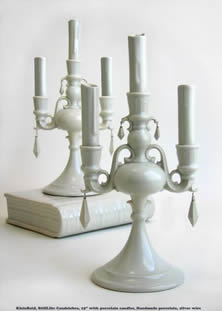 KleinReid is an innovative design studio based in New York City that was formed in 1993 when James Klein and David Reid began collaborating, creating refined vases, lighting, serveware, soft goods, jewelry and fine art prints. Prior to their collaboration, Klein received an M.F.A. degree from Alfred University and Reid received his degree from Cranbrook, both noted schools of art and design.
KleinReid is an innovative design studio based in New York City that was formed in 1993 when James Klein and David Reid began collaborating, creating refined vases, lighting, serveware, soft goods, jewelry and fine art prints. Prior to their collaboration, Klein received an M.F.A. degree from Alfred University and Reid received his degree from Cranbrook, both noted schools of art and design.
Included in Ceramics Illuminated, is a beautiful porcelain candelabra from the KleinReid still life series designed in 2004. Playfully titled the Happy Prince Candelabra, this 15-inch-high mold-made piece with its very white porcelain body is manufactured in China, where porcelain was first discovered more than two thousand years ago. It is one of the more monumental pieces in the still life series which includes porcelain fruit, books, vases, and more. While this porcelain candelabra doesn’t illuminate, but merely references illumination, each of the three porcelain candles is removable and “real” candles can be substituted. It begs the question – why would one want to substitute wax candles in this candelabra when the imaginary illumination, felt in the form of both light and heat, is so magically successful in this unique porcelain format.
KleinReid have designed with Eva Zeisel, Dansk, MGlass (of Portugal) and Herman Miller. Their work is sold in museum shops, boutiques, and design stores in the U.S., Canada, Australia and Japan and exhibited worldwide. It is in the collection of the several museums and owned by the last two first ladies.
While illumination forms a integral part either real or imagined, of every artist and work included in Ceramics Illuminated, no artist has been more creatively committed to marrying the translucency of porcelain with lighting technology, be it installations, chandeliers, wall pieces or fountains, than Margaret O’Rorke. Born in 1938, trained as a painter and ceramic artist, the past twenty years have focused on her exploration of the creation of exquisite thrown forms that emit light.
O’Rorke lives and works in Oxford, England. She has two National Diplomas in Design including a painting degree from the Chelsea School of Art and her pottery degree from the Camberwell School of Art. Featured in this special exhibition, Ceramics Illuminated, is Ice Mountain, created in March 2009, one small example, just 8-1/2 inches high, of a magical grouping of translucent peaks that illuminate our imaginations and take us to a crisp, seductive world, where one can play with reality. She has exhibited up to 32 of these Ice Mountains (in three sizes) in other exhibitions, most recently at the Northern Clay Center in Minneapolis. If one were traveling through this mountain range, would one need a parka or just a sense of adventure?
O’Rorke has written about her involvement with light sculpture, “The translucency of fine high-fired porcelain has led me...to throw forms which give light. These ideas stem from the nature of the material, forms that can grow from the potter’s wheel, the process of firing and a sense of adventure with light and space.” She creates the initial work in her studio located next to her 15th century farmhouse. It seems almost contradictory that her thrown forms become designs that are then manufactured as cast porcelain lights.
 Curt Benzle is the only artist included in the Ceramics Illuminated exhibition who has actually created his own lithophanes by both carving wax models and utilizing a photo process. Benzle has worked with translucent ceramic materials since the 1970s when he was an undergraduate at the Ohio State University. He attended graduate school at Northern Illinois University where he developed a body of work that focused on the stamping and carving of porcelain, ceramic stains, and the transmission of light. In 1979, he moved back to Ohio, where he met Laurel Blair in Toledo. Mr. Blair was delighted to find an artist who shared his passion for translucent porcelain and was eager for Curt Benzle to reproduce lithophanes from the Blair Museum collection as a commercial product. Instead Benzle continued his creation of an original line of lithophanes that incorporated traditional carved wax techniques with his ongoing interest in stained porcelain.
Curt Benzle is the only artist included in the Ceramics Illuminated exhibition who has actually created his own lithophanes by both carving wax models and utilizing a photo process. Benzle has worked with translucent ceramic materials since the 1970s when he was an undergraduate at the Ohio State University. He attended graduate school at Northern Illinois University where he developed a body of work that focused on the stamping and carving of porcelain, ceramic stains, and the transmission of light. In 1979, he moved back to Ohio, where he met Laurel Blair in Toledo. Mr. Blair was delighted to find an artist who shared his passion for translucent porcelain and was eager for Curt Benzle to reproduce lithophanes from the Blair Museum collection as a commercial product. Instead Benzle continued his creation of an original line of lithophanes that incorporated traditional carved wax techniques with his ongoing interest in stained porcelain.
Benzle met with Walter Ford in 1982, and became intrigued by the concept of photo-mechanical processes in the production of ceramic products. After extensive research of his own, Benzle developed a technique for creating lithophanes using photographic images. Details about this process are included in the book Lithophanes by Dr. Margaret Carney, published in 2008 by Schiffer Publishing.
None of Curt Benzle’s lithophanes are included in this special exhibition featuring non-lithophane ceramics that interact with light. Ceramics Illuminated features his Floral Sconce, created in 2009. This piece is comprised of porcelain on glass with cubic zirconia detail. Just as this exhibition has revealed that ceramics and light have not been explored with any frequency by ceramic artists, Benzle has written the corollary, that “translucency in porcelain is a great example of an overlooked aesthetic virtue.” He elaborates on the differences between translucency and transparency, terms that people often confuse. He notes that people some times believe that “translucency is often misperceived as being unrealized transparency.” He continues, “This is no more the case than lingerie is unrealized nudity.” He states, “translucency suggests” and “translucency implies.” Benzle’s art work demonstrates his mastery of the elusive quality of translucency in porcelain. Illuminating his work is essential in realizing the full beauty of his creations.
 One completely mesmerizing piece in the exhibition was created by a collaboration of artists who go by the name the Non Fiction Design Collective. The four artists are Steven Thurston and Rebecca Harvey, both faculty at the Ohio State University, and Guy Michael Davis and Katie Parker, on the faculty at the University of Cincinnati College of Design, Art, Architecture, and Planning. Rattus Norvegicus Rex or The Rat King Chandelier, a.k.a. The Brown Rat King, was created in 2008 utilizing porcelain, glass, hardware and wiring. The porcelain rats are mold-made using rapid prototyping methods available in the ceramics department at the Ohio State University in Columbus, Ohio. Artists Steven Thurston and Guy Michael Davis worked together to scan a taxidermy rat using a Konica Minolta three-dimensional scanner. Digital files were used to print prototypes in a plaster-like material via a Z-Corp 510 three-dimensional printer. The plaster molds for casting porcelain rats were made from these prototypes. In this particular chandelier, the rats hang from looped tails with red glass berries in their mouths. They are surrounded by a ring of acorns, leaves and glass beads. An article by Steven Thurston in the February 2009 issue of Ceramics Monthly describes the process used to create parts of this masterpiece and related processes in detail.
One completely mesmerizing piece in the exhibition was created by a collaboration of artists who go by the name the Non Fiction Design Collective. The four artists are Steven Thurston and Rebecca Harvey, both faculty at the Ohio State University, and Guy Michael Davis and Katie Parker, on the faculty at the University of Cincinnati College of Design, Art, Architecture, and Planning. Rattus Norvegicus Rex or The Rat King Chandelier, a.k.a. The Brown Rat King, was created in 2008 utilizing porcelain, glass, hardware and wiring. The porcelain rats are mold-made using rapid prototyping methods available in the ceramics department at the Ohio State University in Columbus, Ohio. Artists Steven Thurston and Guy Michael Davis worked together to scan a taxidermy rat using a Konica Minolta three-dimensional scanner. Digital files were used to print prototypes in a plaster-like material via a Z-Corp 510 three-dimensional printer. The plaster molds for casting porcelain rats were made from these prototypes. In this particular chandelier, the rats hang from looped tails with red glass berries in their mouths. They are surrounded by a ring of acorns, leaves and glass beads. An article by Steven Thurston in the February 2009 issue of Ceramics Monthly describes the process used to create parts of this masterpiece and related processes in detail.
According to their captivating website (www.nonfictiondesigncollective.com) the mission of the Non Fiction Design Collective, is to “intentionally blur the line between the hand and the tool, between the idea and the concept.” They are interested in “merging the worlds of ceramics & printmaking and the remaking and reuse of industrial cast-offs.” They summarize their work beautifully, their “limited production is a mixture of intent and accident – a constant tug between addition and subtraction.” Their work is old and fresh simultaneously. They raise their own questions and then answer them. For example, as noted on their website, on the question “When is a light not a lamp?” they respond “When it has hanging strands of light bulbs and rats...”
If one believes that ceramics and light have had hundreds if not thousands of years of interplay and that illuminated ceramics are the norm, then one is sadly mistaken. While Ceramics Illuminated is not comprehensive, including every single object created from clay with the intent or necessity of illumination, there are not hundreds or even twenty other makers waiting to have their work featured in Ceramics Illuminated Part Two. Why such innovative artists as ceramists, with vast knowledge about raw materials, clay and glazes, and technology in general have not aspired to transform our world every decade or so with a blending of ceramics and illumination, is not known. Judging by what the Roman lamp makers, Chinese potters, 19th century porcelain manufacturers, and contemporary artists such as Ted Randall, Rudi Staffel, Jack Earl, Curt Benzle, Linda Cordell, Ka-Kwong Hui, Margaret O’Rorke, the Non Fiction Design Collective, and KleinReid have created, it is a loss for the consumer, collector, and potential customer. It seems like such a natural combination – light and ceramics, ceramics and light. It may be a while before another artist dedicates his or her artistic explorations to such a quest. Fortunately illuminated ceramics are worth the wait.
The Ceramics Illuminated exhibition opens at the Blair Museum of Lithophanes, located at the Toledo Botanical Garden, 5403 Elmer Drive, Toledo, Ohio on Sunday September 6, 2009, from 2-4 p.m. It will remain on view on weekends and by prior appointment through October 31st. It is part of a celebration of the 100th anniversary of the birth of the Museum’s founder, Laurel G. Blair. There will be refreshments, a silent auction, a lithophane raffle and more.

